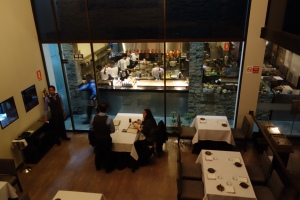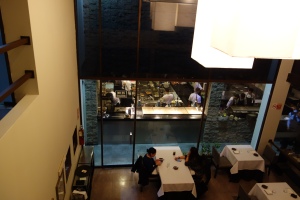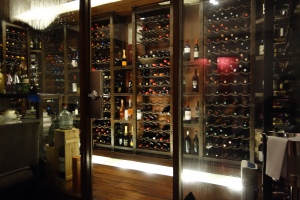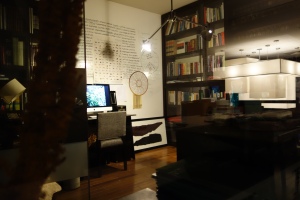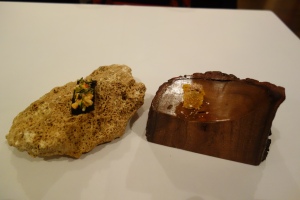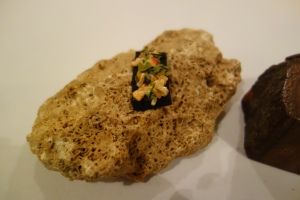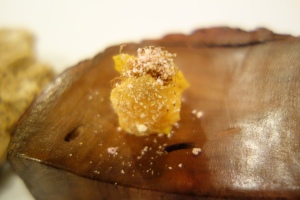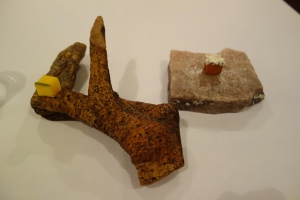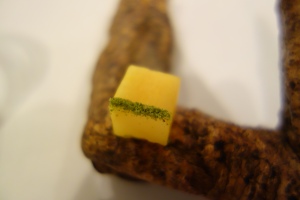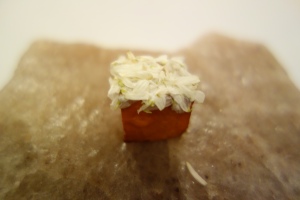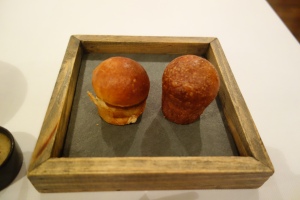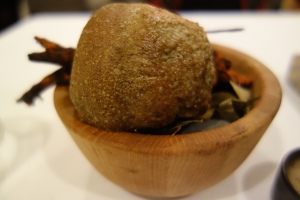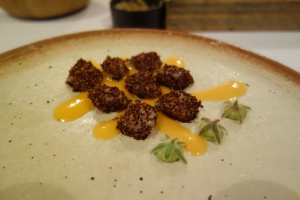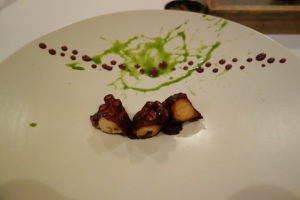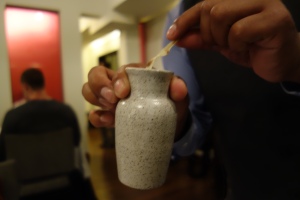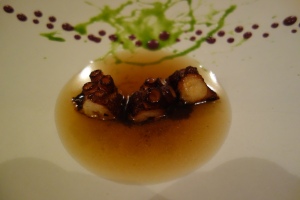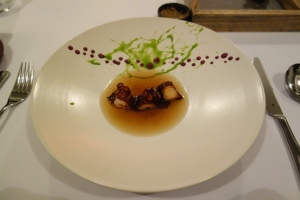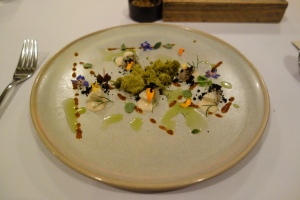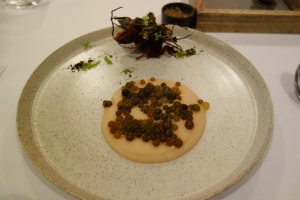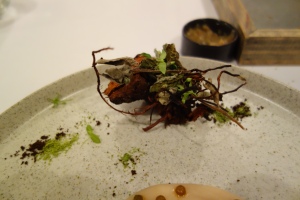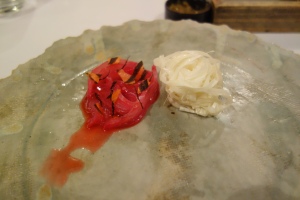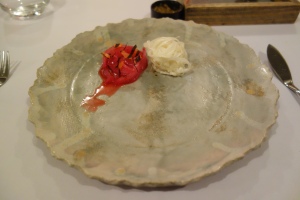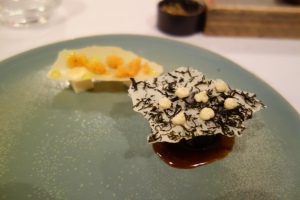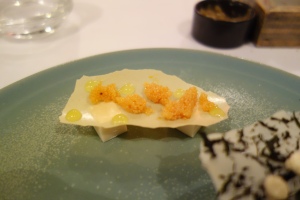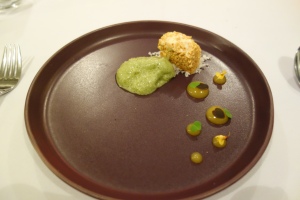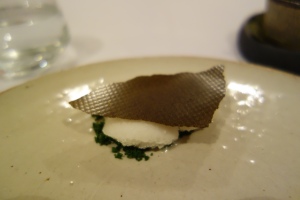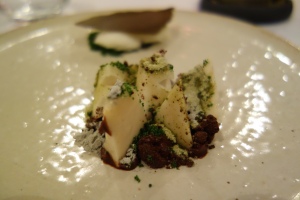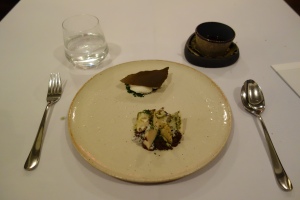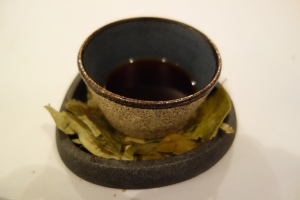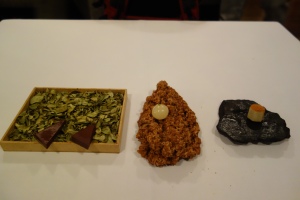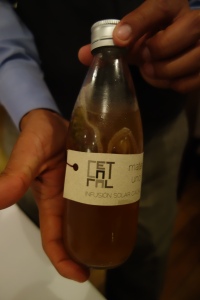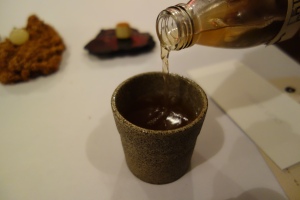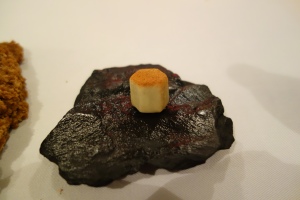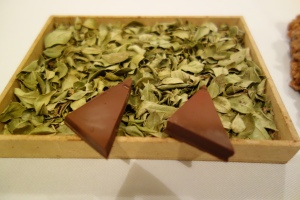- Old Address: Cantuarias 175, Miraflores District 15074, Peru
- New Address: Av. Paz Soldán 290, San Isidro, Lima 27 – Perú
- Phone: +51 1 2424422.
- Price (after tax + tip, excl. drinks): > $100
- Courses: (20 main/22 total): 1 amuse, 1 bread, 16 savory, 4 dessert
- Rating: 14/20
- Value: 2/5
- Dining Time: 240 minutes
- Time/Course (total): 11 minutes
- Chef: Diego Muñoz (Mugaritz, el Bulli, Royal Mail Hotel, Bilson’s in Sydney Australia)
- Style: Peruvian
- Notable: First fine-dining restaurant to focus all the way back in the 90’s on Peruvian food
I think this 20 year retrospective menu, which AyG only served in the last month of their operations in their old address, in January 2014, was one of the more memorable meals I had partaken. (They’ve since moved to the Financial District of Lima, in a new space called “Casa Moreyra”.) Was the food great? In all honesty, not really. There were no eye-opening combinations, nor any dish I thought was excellent (i.e. 5/5), though I remember the liquid nitrogen chirimoya dessert (like styrofoam pillows), and the peking cuy (guinea pig). Puzzling was the chifa dish that was just a fried piece of fish and puffed rice in oyster sauce. “Sole meuniere” was just a slab of plain fish. Chicken liver, an ingredient pinched in taste compared to its fowl-ier brethren, was presented without embellishment. Purely gastronomically, I had much better experiences at Central and Maido.
But it seemed almost beside the point. The food was secondary to the story-telling. The special menu was a celebration of the history of the restaurant. The constraints were clear: the kitchen was going to select a dish from each year, and feature it as a 20 course menu. From there, they wove a story about how a French restaurant in an unstable Lima, eventually found its voice championing the native dishes of Peru, and set up branches all over Latin America and Spain. How they became more experimental over the years, especially the dessert courses. It was interesting to see the evolution of restaurant before our eyes, told through 20 courses.
It seemed purely experiential, the evolution of a restaurant told in 20 dishes. While I didn’t fully enjoy the gastronomic side of it, it appealed to the sentimental side of me. Since it seems churlish to criticise a special menu working under a stringent set of constraints, below I present the menu and photos without further explanation, so you can take my place tableside.
Other Notable Links: Spanish Hipster write-up on the El Viaje menu, the year-long menu directly preceding this, planned together with Massimo Bottura of Osteria Francescana.
The side alley in Miraflores
Voyeurism
To the right, the waiting area
Dining room
The kitchen, helmed by Diego Muñoz.
We arrived early, by Latin American standards. (8pm, most guests started filling the room at 9pm)
Cholopolitan
Cono de Mango
Panes
1994: Foie Gras Times
Apple, grapes, port, chicken foie.
July 14th 1994. French revolution.
The restaurant opens its doors with a sign that said:
Astrid y Gaston Restaurant.
Haute cuisine.It was time for morels,
and foie gras.
They were different times.
1995. Tartare Times
Artisan bread, beef tenderloin, bone marrow, smoked yolk, herbs
Astrid leads.
The freshness of her 20 years conquering it all.
The bar, dining room, tables, dishes, like a dance.Her dance.
1996. The debut of the Tuna
Tuna, tumbo, oriental salad
Something new starts
to beat in 1996.
The beef, the sole
they couldn’t agitate
the heart as they used to.Winds of change.
We could feel them come.
1997. The a lo pobre that wanted to be entrecote
Black beans, sweetbreads, banana
And suddenly, hidden between goose
and grapes, the tacu tacu made its entranceFearful, confused.
not knowing if he would stay.
*meeeeep~~*
1998. Duck tasting
Cured, rillettes, confit
We were always taught
that the kingdom of the duck
was in France.No-one told us his place
was also among the Mochica.
1999. Ingredients get an ID
Free range egg, “Huacho” sausage, quinoa, and asparagus.
Mother earth. Land of the water, the sun, the wind and fire.
Together they transform the products.They create life.
2000. Down to Chile
Sole menieur, hazelnuts.
We were ignorant
of so many things.We could only feel.
We felt we could share our dream.That we were at last ready.

 2001. A voyage across the World
2001. A voyage across the World
Shrimp melcocha
Like our own love story,
Peru and France finally transformed into a single plate.It was time to fly, to discover, to dream.


 2002. Preparing the Land
2002. Preparing the Land
“Chupe” rice, corn and lobster
One never knows why things occur.
They just do.Ideas align, words lose meaning,
everything falls into shape.Everything finds its purpose.
2003. Revelation
Causa de pallares, paiche, “charapita” chilli.
But something was missing.
Something deep, meaningful,
irreplaceable.A voyage across
the Peruvian territory.Drink from its past,
feel its present,
visions of the future.
“Playboy for the hormonal New World crew”
2004. Culinary adventure
Pulpo al cilindro
And the adventure started.
Ancient faces,
ancient people,
nothing was left out.The peace of knowing
that in the kitchen
there are no hierarchies
 2005. Peru as doctrine: 500 years of fusion
2005. Peru as doctrine: 500 years of fusion
Chifa style fish
To discover oneself.
Take off our masks
and feel the joy
of belonging to a place and time.The joy of being free.
2006. From Peru to the World
Street food ceviche
And with freedom comes trust,
dreams, forwardness.Free we could conquer hearts, fearless,
without the heavy fear
of the dark alley.
Finished.
2007. Peruvian cuisine, a movement.
Goat, watercress and roasted onions
Fear, vanity,
disbelief were left behind.By ourselves are no-one,
together we are heaven.We were cooks,
we became a movement.
2008. Mistura
Peking cuy
How to build a bridge
between the countryside
and the city?Between kitchen and tables?
How to celebrate together?
Mistura.
2009. Pachacutec: The dreams of the youth
Suckling pig, sweet potatoes and Andean herbs.
The kitchen can become a window for our dreams.
We just have to open it.



 2010. Peruvian cuisine as the Ambassadors of our country
2010. Peruvian cuisine as the Ambassadors of our country
Suspiro loco
The voice of Peru sounds different.
In its tone we do not find violence nor fear.
Her new voice provokes, seduces, agitates.
2011. A new challenge with new blood
Chirimoya Alegre
It has been a long journey since
Behind we are held by an army of youth,
firm and steady march.It is their time.
2012. Story Telling
Sensitive sphere
Experience and youth, savour the future.
To tell stories.
Through our kitchens, stories are born.
2013. The farewell
Beso de Camu Camu,
Sable salado
mango vainilla,
Formula 44
Sol y Somba
Cafe finca “Tasta”
de Edith Meza Sagarvinaga
Satipo Junín
The end of a lifetime.
20 years of love and battle.A new life and home await for us.
So much to be thankful for.
So much to give back.
End











































































































